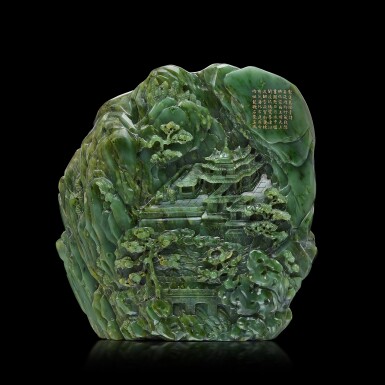Important Chinese Art
Important Chinese Art

Property from the De An Tang Collection | 德安堂藏玉
An imperial inscribed spinach-green jade 'Pengdao Yaotai' boulder, Qing dynasty, Qianlong period | 清乾隆 碧玉雕御題詩蓬島瑤台山子
Auction Closed
April 8, 02:15 PM GMT
Estimate
2,500,000 - 5,000,000 HKD
Lot Details
Description
Property from the De An Tang Collection
An imperial inscribed spinach-green jade 'Pengdao Yaotai' boulder,
Qing dynasty, Qianlong period
德安堂藏玉
清乾隆 碧玉雕御題詩蓬島瑤台山子
23.2 by 7.2 by h. 24.1 cm
An American private collection, acquired between 1940s-1960s.
美國私人收藏,於1940至1960年代入藏
Impressive for its large size, the carving of the present lot is representative of some of the highest quality workmanship of the imperial jade ateliers during the Qianlong period, indicating it would have been a particularly prized possession and possibly a special commission. The outstanding skill of the jade lapidary artist is exemplified by the perfectly carved and carefully composed animated scene, which is enhanced by the translucent and luminous tone of the remarkable Khotan spinach-green jade stone.
The imperial poem carved on the present boulder indicates that the mountainous landscape is likely a reminiscence of Pengdao yaotai, or 'Jade Terrace of Paradise Island', which is one of the Forty Scenes of the Yuanmingyuan. In the ninth year of the Qianlong reign (1744), the Qianlong Emperor commissioned a set of forty paintings from Shen Yuan and Tangdai. The paintings, currently in the collection of Bibliothèque nationale de France, are among the few remaining visual records of the Yuanmingyuan prior to 1860, see Lillian M. Li, 'The Garden of Perfect Brightness 1: The Yuanmingyuan as Imperial Paradise (1700-1860)', MIT Visualizing Cultures, Massachusetts, 2013. The subject matter on the present boulder is most likely based on paintings from the classical cannon, as the Qianlong emperor advocated that jade mountains and carved panels should carry the spirit of paintings by famous past masters.
See a closely related spinach-green jade 'Immortals' boulder in the Palace Museum, Beijing, illustrated in Jasper Wares of Qing Dynasty Collected by the Palace Museum and Manasi, Beijing, 2014, pp. 266-267, pl. 109. See also another related white jade screen carved with similar subject matter, Qing dynasty, in the Palace Museum, Taipei, illustrated in The Refined Taste of the Emperor: Special Exhibition of Archaic and Pictorial Jades of the Qing Court, Taipei, 1997, pp. 204-205, pl. 71.
碧玉玉質,玉質瑩潤,玉色蒼綠,局部略淡,有黑色斑點。山子隨形而雕,中部為山中亭台樓閣坐落於台基之上,樓閣廳堂相連,三人於亭中仰觀山景。右上角山石山刻《製蓬島瑤臺詩》,依次「名葩綽約草葳蕤,隱映仙家白玉墀。天上畫圖懸日月,水中樓閣漫琉璃。鹭拳淨沼波翻雪,燕賀新巢棟有芝。海外方蓬原宇內,祖龍鞭石竟奚為。」背面雕雙鹿於祥雲蒼松山石之間。雕刻生動極致,細節刻畫游刃有餘,構圖錯落有致。
蓬島瑤台是圓明園四十景之一,建於雍正三年(1725年)前後,時稱蓬萊洲,乾隆初年定名蓬島瑤台。乾隆元年(173年)正月,乾隆帝命內廷畫師按康熙朝繪製的避暑山莊三十六景圖,為圓明園各「殿宇處所」起稿分景畫樣,其後不久又改令唐岱、沈源二人繪畫。乾隆六年又增入「方壺勝境」、「蓬島瑤台」和「慈雲普護」三圖,最終成為《四十景圖》。此《四十景圖》絹本彩繪目前收藏於法國國家圖書館中,見李明珠,〈The Garden of Perfect Brightness 1: The Yuanmingyuan as Imperial Paradise (1700-1860)〉,《MIT Visualizing Cultures》,麻薩諸塞州,2013年。
乾隆皇帝尤喜具有「畫意」玉器,不論宮廷造辦處或是蘇州、揚州玉作,在製作玉器時皆對畫樣及選料方面尤為講究,而紋飾主題則多取材自宮廷收藏之畫作。類似的例子,見北京故宮博物院藏一件清碧玉雕三老圖山子,著錄於《故宮博物院藏清代碧玉器與瑪納斯》,北京,2014年,頁266-267,圖版109;另見台北故宮博物院藏一件清白玉插屏,其主題類似,著錄於《宮廷之雅:清代仿古及畫意玉器特展圖錄》,台北,1997年,頁204-205,圖版71。
